

Here’s What Pushes People to Buy Homes in 2015
If you want to sell your property quickly, at near the asking price, it is important to know why people are buying. In this post, Realtor.com chief economist, Jonathan Smoke, suggests we pay attention to the five main triggers for home buyers: they have grown tired of their home and want a change, interest rates are exceptionally low, housing prices are favourable in many markets, they need or want more living space and they have the money to spend. To read more click here. The post Here’s What Pushes People to Buy Homes in 2015 appeared first on Team Realty. Source: Blog

Canadian Home Prices Are Growing At One Of The Fastest Paces In The World
The Canadian real estate market continues to boom, according to this Financial Post offering. With a year-over-year increase of 8.2%, Canada ranked 4th of the 23 countries studied in Scotiabank’s report Global Real Estate Trends, behind Ireland (13.3%), Sweden (10.5%) and Australia (8.3%). However, the report warns the trend could change if economic uncertainty and high unemployment counterbalance the attraction of low borrowing costs. To read more click here. The post Canadian Home Prices Are Growing At One Of The Fastest Paces In The World appeared first on Team Realty. Source: Blog

5 tips for eco-friendly renovations
If you are renovating, you should consider the green strategies suggested in this realestate.com post by Danielle King. For example, add insulation to the roof and external walls and you could save 25% on energy costs. Replace inefficient windows or add window film since up to 40% of your heating can be lost through windows in winter. Energy efficient appliances, LED lighting and solar panels will also contribute savings, while protecting the environment. Implement water collection techniques to use rainwater for toilets and the garden. Include water efficient faucets and showerheads. Add high-flow taps that make baths and washing machines fill quickly. Use low/no Voltatile Organic Compound (VOC) materials where possible, and non-toxic paints.to read more click here. The post 5 tips for eco-friendly renovations appeared first on Team Realty. Source: Blog

8 Mistakes That Could Screw Up Your Home Sale
Usually we hear “buyer beware”, but real estate author Michael Corbett advises sellers to beware and gives 8 reasons why in this trulia.com post. Always work with professional help, including a real estate agent. Their expertise, experience, neighbourhood knowledge and resources will help you plot a course through the selling process. Overpricing is a temptation to be avoided since most buyers are savvy and have the advice of an agent. Ensure that you use high quality photos because 90% of buyers shop for home online. Complete repairs like leaky faucets before listing your home to avoid negotiations over what the repairs will cost potential buyers. Spend time cleaning and removing clutter since untidiness makes your home seem smaller. Stage your backyard as if it were another room and maintain the landscape so it appeals to your viewers, especially in summer and fall when we enjoy outdoor activities. Disclose all information including issues that may jeopardize a sale to avoid liability after the sale. Finally, remember this is a business deal and emotions can get in the way. A low ball offer is an opportunity to negotiate, not a reason to be insulted. To read more click here. The post 8 Mistakes That Could Screw Up Your Home Sale appeared first on Team Realty. Source: Blog

What’s the best property type for your first home?
Inexperience can cause first time home buyers to be confused by the multitude of available options. This post by Caroline James is an excellent introduction to the advantages and disadvantages of five popular property choices: a large detached house on a suburban block, a small home on a sub-divided lot, a townhouse, an apartment in a small block and an apartment in a high rise block. To read more click here. The post What’s the best property type for your first home? appeared first on Team Realty. Source: Blog

Is It Time to Downsize? Ask Yourself These 4 Questions First
If you’ve reached the time of life where you are contemplating downsizing your home, the first question to ask, according to this Realto.com post, is what kind of lifestyle do you want after downsizing? By defining how you want to live, you can narrow your search and focus on housing that will meet those requirements. For example, if you want to escape the bluster of winter and relax on a beach, local climate conditions and geography will drive your hunt. Or, if you like social activities, you would seek active adult communities where you can interact with like-minded people. The next step is to consider the financials by asking what will you budget look like? After that, ask yourself if you have enough equity in your home to make a profit. If you have enough equity, you can buy your next home outright or bring a sizable down payment on closing day. Finally, ask if you will be able to find another home that’s affordable in a seller’s market. For those with some financial clout, realtor Debra Whitfield recommends using an equity line of credit on your current home or a home equity conversion mortgage to buy your next home, before selling your current property. That gives you time to find a suitable property instead of being rushed to select whatever happens to be on the market after your house is sold. To read more click here. The post Is It Time to Downsize? Ask Yourself These 4 Questions First appeared first on Team Realty. Source: Blog
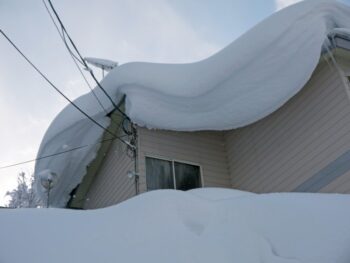
Why Homeowners Should Beware of Icicles
Ottawa’s freeze-thaw weather patterns often create sparkling icicles that look magical. But, they actually identify a dangerous — and potentially costly — hazard, an ice dam. Imagine coming home from work to find water streaming down your interior walls and soaking into the hardwood of your foyer. What would you do? What Is An Ice Dam After frantically tracing the flow, you would find that a pool of water had formed behind a thick ridge of ice in the gutters – hence the term ice dam. Snow on the roof had been melted by heat loss, causing water to collect behind the dam. And, the water was seeping through the shingles and into the house exposing it to significant potential damages. After calling three roofing companies and getting no answer, you climb up a ladder to the second level, stand on a stool at a precarious angle, hold the gutter for support with one hand and use the other to smash the ice with a hammer. Eventually, you clear the dam but not before almost sliding off the roof … twice. How To Remove An Ice Dam Luckily, in this hypothetical case, there was only minor water damage, but the do-it-yourself approach was very risky and you did bend the gutter. Homeowners experiencing the effects of an ice dam — or those worried about a leak — should hire a professional roofing company to remove any ice buildup and assess for further preventive measures. Safe removal of snow and ice should be accomplished by qualified technicians, who are fully trained in fall-arrest prevention, use the appropriate safety gear and equipment and have full insurance coverage. Instead of using hammers, chisels and salt, they will steam away the ice and remove excess snow with rakes designed for the purpose. How To Avoid Ice Dams To prevent ice dams, you must keep heat from reaching the roof, so the snow won’t melt in the first place. That goal is accomplished by insulating and ventilating the attic space to maintain the roof surface at, or near, outdoor temperatures. Any breach into the attic from the heated living space needs to be insulated. For homes with finished attics, this may involve opening up the ceiling. Periodically check your roof for snow coverage because the snow’s weight alone, which should not exceed 20 to 25 lbs/sq ft, can cause damage. Depending on moisture content, snow weighs about 1.25 lbs/sq ft for each inch of depth, so 20 inches is a considerable burden. And, if you see icicles, investigate further. Professional roofers can provide accurate measurements, remediation or maintenance on a scheduled or as-needed basis. The post Why Homeowners Should Beware of Icicles appeared first on Team Realty. Source: Blog

Congratulations to our Award Winners
At Royal LePage Team Realty helping YOU is what we do and we couldn’t do that without a dedicated network of real estate professionals. We would like to take this opportunity to congratulate our 2015 Award winners and thank them for their hard work and dedication. We are so proud to work with those who consistently go above and beyond to ensure their clients are provided with excellent real estate service. Looking forward to an awesome 2016! jQuery(document).ready(function($) { var mpImageSlider = $(“.motopress-image-slider-obj#56e5df6483fc4”); if (mpImageSlider.data(“flexslider”)) { mpImageSlider.flexslider(“destroy”); } if (!true) mpImageSlider.css(“margin-bottom”, 0); mpImageSlider.flexslider({ slideshow: true, animation: “fade”, controlNav: true, slideshowSpeed: 3000, animationSpeed: 600, smoothHeight: false, keyboard: true }); }); jQuery(document).ready(function($) { var mpImageSlider = $(“.motopress-image-slider-obj#56e5df6484e44”); if (mpImageSlider.data(“flexslider”)) { mpImageSlider.flexslider(“destroy”); } if (!true) mpImageSlider.css(“margin-bottom”, 0); mpImageSlider.flexslider({ slideshow: true, animation: “fade”, controlNav: true, slideshowSpeed: 3000, animationSpeed: 600, smoothHeight: false, keyboard: true }); }); The post Congratulations to our Award Winners appeared first on Team Realty. Source: Blog

Why Listing In January or February Can Make Sense
Although it may seem odd, listing in the winter months can be advantageous for sellers. Statistically, there are indeed more buyers in the spring market. However, there are also more homes for sale, including properties similar to yours. With more competition for the pool of buyers, your chances of finalizing a deal may actually be reduced. Here are several reasons to list in January or February. Financial Planning And Taxes Many families check their finances at year end and start planning their tax returns. And, because of the holiday festivities, it’s often the time for discussions and decisions about gifting, inheritance, upgrading to a larger home or downsizing to a smaller one and homeownership versus renting. Whether it’s a new buyer who moves quickly or a previously active buyer who re-engages, these house hunters are around in January and February and will look at your home if it’s for sale. If You List They Will Come Because of online advertising, buyers look at listings all day, every day. They have apps on their phone, get listings texted and emailed to them, and don’t care about the time of year. They realize the home won’t show as well in the dead of winter, so providing photos of your home during these times of year will enable buyers to envision it in the warmer seasons. Winter Buyers Are Highly Motivated Buyers looking in January and February are serious. They know what they want, have often been at it for many months and are tired of the real estate hunt. This is your target buyer and, in part, they’re why it’s better to list in January than to wait until spring. Your property will certainly stand out if it’s the only one like it listed. Offering your home for sale in the “offseason” means less competition which changes the market’s supply-and-demand balance. The demand is far greater than the supply. And, because of the reduced inventory, the seller can often take a little more time to consider offers and negotiate a higher price. The post Why Listing In January or February Can Make Sense appeared first on Team Realty. Source: Blog

First Time Homebuyers Government Incentive Programs
Thinking of buying your first home? If so, it may be time to get on with it, especially considering the possibility that interest rates will rise. Using government incentive programs that encourage first time homebuyers to enter the real estate market, you can realize additional savings. And, mortgage financing has been almost free for some time, but economic signals point to those costs rising. Mortgage rates may increase Several factors are threatening to push Canadian mortgage rates higher even as the Bank of Canada tries to hold its overnight lending rate down. Fixed mortgage rates are linked to long-term Canadian government bond yields, which are tied to U.S. bond yields. Those rates have risen since September as investors have come to expect the U.S. Federal Reserve to boost rates based on the U.S. economy. Borrow from yourself The Canadian government’s Home Buyers’ Plan (HBP) allows first time home buyers to borrow up to $25,000 from their RRSP for a down payment to buy or build a qualified home, tax-free. If you purchase with someone who is also a first time homebuyer, including your spouse, you can both access $25,000 from your RRSP for a combined total of $50,000. The HBP is considered a loan, so if you participate in the Plan, you must repay the amount you withdrew within a 15-year period, in the amount of 1/15 per year. If you repay less than that amount, the difference is added to your taxable income and you are taxed at the applicable rate. Reduce your income tax The federal Home Buyers’ Tax Credit helps recover closing costs (legal expenses, inspections, land transfer taxes) so you can save more for money for a down payment. At current taxation rates, it works out to a rebate of $750. If you buy in Ontario, there is another rebate of up to $2,000 available to help offset the land transfer tax. In Toronto, you can also receive a rebate up to $3,725 for municipal land transfer taxes. With the current economic uncertainty and the advantages of government incentive programs, now may be the right time for first time home buyers to lock in a mortgage at the low rates and buy a home. The post First Time Homebuyers Government Incentive Programs appeared first on Team Realty. Source: Blog

Saving Strategies for Every Age
We all want to save more money, but doing it requires a plan. And, the best approach to saving depends on the stage of life you’re in because each phase has unique financial commitments. Although individual circumstances vary, these generation-specific suggestions will point you in the right direction. Millennials (19-35) Millennials, born between 1980 and 1996, are actually better than Gen Xers at money management, according to financial journalist Vera Gibbons. But, they tend to live in the moment and prefer instant gratification to long-term financial planning. And, because personal finance is not a core subject in school, they may not know much about how to manage money. Try these strategies. each payday, set aside money to “pay yourself first” and use it for an emergency fund learn fine art of delaying gratification so you have the self control to say no to yourself avoid paying rent, which can cost up to 30% of your income, by living at home pay off student debt with an income-based loan repayment plan use a budgeting tool so you know where your money is going give yourself a weekly allowance to keep discretionary spending in check make small, manageable reductions to your expenses which leaves more for savings contribute to your employer’s retirement plan manage your credit score as it affects your ability to obtain mortgage or other financing Gen Xers (36-50) For Generation Xers, born between 1965 and 1979, have less time to build a nest-egg for retirement, so it’s imperative to contribute regularly to their retirement savings during these peak income earning years. Managing cash flow at this stage is particularly challenging. Consider these options. avoid buying more home than you can afford using cash will make you think harder before letting it go pay yourself first entertain at home rather than going out overestimate expenses and make small, manageable spending reductions contribute to your employer’s retirement plan Baby Boomers (51-69) Most Baby Boomers, born between 1946 and 1964, are in better financial shape than their younger counterparts, but only 60 percent report having retirement savings and 93 percent are providing financial support to adult children. So, they face the dangerous combination of being under-saved and long-lived. Here are a few ideas to safeguard your future. delay retirement or return to work to generate income explore the downsizing option and/or ways to leverage home equity accelerate retirement savings and allocate investments properly consider long-term care insurance reduce expenditures and eliminate high cost items like transportation plan to retire in, or move to, an area with lower expenses adjust your standard of living The post Saving Strategies for Every Age appeared first on Team Realty. Source: Blog
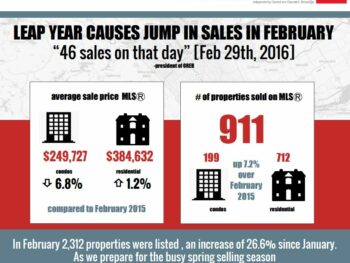
Real Estate Snapshot February 2016
What a difference a day makes! An extra day in February saw 46 sales on that day (February 29th) as per the Ottawa Real Estate Board’s news release March 3rd. See the full Ottawa Real Estate market snapshot for February and the full story from the Ottawa Real Estate Board below. With spring around the corner, we’re starting to see more homes come on the market, if you’re thinking of selling now is a great time to get your home listed with a real estate professional. While statistics are useful in establishing trends they should not be used as an indicator of an increase or decrease in value of specific properties. If you are curious about the value of your home and/or specific neighbourhood statistics we would be happy to provide you with a no cost no obligation market evaluation of your property. Contact any one of our 23 offices or email us at info@teamrealty.ca From the Ottawa Real Estate Board March 3rd, 2016 Extra day in leap year causes jump in sales for February Members of the Ottawa Real Estate Board sold 911 residential properties in February through the Board’s Multiple Listing Service® system, compared with 850 in February 2015, an increase of 7.2 per cent. The five-year average for February sales is 908. “Although the weather was very unpredictable this month, with many highs and lows and several winter storms, the Ottawa resale market only saw activity pick up,” says President of the Ottawa Real Estate Board, Shane Silva. “Residential and condo sales combined increased by 52.3 per cent since last month. However, we need to factor in the leap year, which added an extra day to the month of February, and 46 sales on that day.” February’s sales included 199 in the condominium property class, and 712 in the residential property class. The condominium property class includes any property, regardless of style (i.e. detached, semi-detached, apartment, townhouse, etc.), which is registered as a condominium, as well as properties which are co-operatives, life leases and timeshares. The residential property class includes all other residential properties. “In February, 2,312 homes were listed, up 26.6 per cent since January, and inventory on hand at the end of February rose by 10.7 per cent since January,” says Silva. “We’re starting to see more homes coming onto the market in preparation for the busy spring selling season. If you’re thinking of putting your home on the market, this is a great time to do so.” The average sale price of a residential-class property sold in February in the Ottawa area was $384,632, an increase of 1.2 per cent over February 2015. The average sale price for a condominium-class property was $249,727, a decrease of 6.8 per cent over February 2015. The Board cautions that average sale price information can be useful in establishing trends over time but should not be used as an indicator that specific properties have increased or decreased in value. The average sale price is calculated based on the total dollar volume of all properties sold. “The highest concentration of properties sold continues to be in the $300,000 to $400,000 price range, followed by the $200,000 to $300,000 range,” says Silva. “These price ranges continue to have the highest concentration of properties sold – residential and condo – while two-storey, bungalow, and one-level condos have the highest concentration of buyers. In addition to residential and condominium sales, OREB Members assisted clients with renting 414 properties since the beginning of the year.” The post Real Estate Snapshot February 2016 appeared first on Team Realty. Source: Blog

7 Deadly Sins of Home Renos
Homeowners who renovate only to boost resale value should aim for a return on investment (ROI) of three dollars for every dollar invested. Resale renos should be neutral in colour and conservative in tone so they appeal to the maximum number of potential buyers. And, cost control always trumps elegance. In fact, some renovations can actually damage your home’s value. These supposed improvements not only add nothing to your bottom line, they may make your home less attractive to potential buyers and bring down its value. Here are seven such expensive mistakes to avoid. Pools A pool will chase away numerous buyers due to maintenance, public liability, insurance and local government laws regarding fencing and safety barriers. Don’t waste the money. Skip the Sunroom Unless you want the exposure to nature, avoid this addition which yielded only 48.7 percent ROI according to Remodelling magazine’s 2015 statistics. Converted Garage Some homeowners see converting a garage as a cheaper way to add more living space than building an addition – and it is. But, many buyers prefer a garage to protect assets from the cold and snowy conditions. And, a garage is much more valuable than an extra room. Fancy Faucets and Lighting Fixtures For kitchen or bathroom renos, avoid ornate fixtures for two reasons. First, you reduce the pool of buyers due to the cost. Second, stylized fixtures will appeal only to a small number of potential buyers, those who share your taste, further reducing your chances to sell. Eliminating a Bedroom or Powder Room In older homes, combining smaller rooms in the public living space might add to the value and appeal to homeowners who like large, open spaces. Eliminating a powder room, however, is a bad idea. And turning a bedroom into a master closet or combining two bedrooms to create a large master suite may not pay. As Kevin Brown Jr., president of Praedium Real Estate Services points out, “You’ve eliminated a whole living space.” Elaborate Landscaping A basic make over is the surest way to make money back from your outdoor outlay. Avoid overspending. Things That Are Invisible Adding insulation, window upgrades, or air conditioning does not increase the value of a property as much as some sellers believe. This type of feature can add to the marketability, not the value. The post 7 Deadly Sins of Home Renos appeared first on Team Realty. Source: Blog

The Do’s and Dont’s of Basement Storage
This article from Bob Vila gives eight handy tips to consider when using your basement for storage. The suggestions include taking advantage of vertical space by building up and not out, using open shelves for frequently-used items and built-in cabinets to conceal toys or cleaning supplies, storing off-season gear in sealed bins to protect from moisture and dust, using a pulley-hoist to store heavy or bulky items from the ceiling, protecting tools stored in the open with a coating of machine oil to prevent rust and running a humidifier in the basement to suck moisture from the air and combat mold or mildew. To read more click here. Source: Blog

What You Need to Do When Saying Goodbye to Your Home
Although you’re excited about moving, there are easy ways to reduce the ache you feel when thinking about leaving the old abode. According to this Realtor.com post by Lisa Davis you could throw a going away party with the neighbours who shared your journey over the years. Toast your soon-to-be former residence. Leave a reminder of your presence for future generations like a signature on a rafter in the attic. To read more click here. Source: Blog

Reno Investments Providing the Highest Returns
This detailed Home Inspection Network post provides useful data to anyone who is considering a home renovation. Author Bev Siciliano begins by explaining what many do not realize – we might not fully recoup our investment when the home is sold. For that reason alone, home renovations should be analyzed individually to ensure we get the highest return on investment (ROI). Generally, renovations that provide the best return on resale are superficial upgrades, like painting and decorating, with limited capital outlay and maximum impact. According to the Appraisal Institute of Canada’s latest Home Renovation Survey, renovations with the highest return potential are kitchen and bathroom renos at 75 -100%, followed by interior and exterior painting at 50 – 100%. Skylights rate the lowest potential return on investment (ROI) at 0 – 25%, with swimming pools at 10 – 40% and landscaping, fences and interlock at 25 – 50%. Central air, decks, window/door upgrades, fireplace installs, rec room or garage additions, new flooring, and basement renos have a potential ROI of 50 – 75%. To read more click here. Source: Blog

The 3 Most Common Reasons a Home Inspection Kills a Deal
In this Redfin.com post, home inspector Dylan Chalk underscores the importance of a home inspection by identifying how they can prevent a potential sale. The most common reason is the home is not what it appears to be, especially in the case of a “flipped home”, one purchased and updated with the intention of making as much profit as possible. The inspection reveals there are more repairs and updates than the buyer expected. Problems with the core systems of a “fixer” house (foundation, frame, roofline, floor plan, drainage and access) add cost and complexity to the new homeowner’s projected budget making the deal less attractive. To read more click here. Source: Blog

5 Questions to Ask Before Replacing Your Roof
Most of us have little or no experience with re-roofing, so this post by home reno expert Bob Vila is a valuable guide to the questions a homeowner should ask before hiring a roofer. First, ask for an estimate that is comprehensive enough (permits, inspections, materials, labour, contingency) to establish a firm budget. Discuss the proposal in detail with the contractor. Find out what materials are being used and get the specifications in writing. Avoid cheaper, low quality materials, especially the shingles, because sub-standard materials reduce a roof’s life expectancy costing you more over the long term. Inquire how the project will be accomplished – installing shingles on top of the existing materials may seem cheaper, but removing the existing roof materials will provide a chance to inspect the roof deck in case repairs are needed. Ask if your contractor is licensed, insured, and bonded so you aren’t liable for any accidents during the project. Finally, check how long the roof will last and ask about warranty coverage for materials (Owens Corning shingles are guaranteed for 50 years) and installation (most small contractors do NOT warrant workmanship). To read more click here. Source: Blog

An Economist’s Letter to Millennials Who Can’t (Yet) Buy a Home
This post from Jonathan Smoke, chief economist at realtor.com, explains what Millenials can do to help themselves along the path to home ownership. For example, a high debt burden will restrict their ability to qualify for a mortgage, and the amount they can get, so they need to limit their total debt payments (student loans, credit cards, car loans, etc.) to less than 15% of their income. Smoke also covers the importance of improving their credit score, saving as much as they can for a down payment and creating an emergency fund for unexpected bills. To read more click here. Source: Blog

8 steps to getting started in property investment
This propertyinvestment.com post from Nila Sweeney is an excellent primer for those who want to start a property portfolio. First, check your finances to see how much you can invest and get mortgage pre-approval. Then, define what success means for you, as well as the level of risk you are comfortable with, and set your goals. Next, start budgeting and create a purchase plan. Finally, research the market for opportunities that meet your criteria and approach them as business transactions, applying logic rather than being swayed by your emotional attachment. To read more click here. Source: Blog

Don’t tax my dream campaign succeeds
The efforts of the Ontario Real Estate Association (OREA) and the Progressive Conservatives were recently rewarded when the provincial government decided they would NOT be expanding the municipal land transfer tax program. Liberals keep election promise In an unexpected announcement during the legislature’s question period, Municipal Affairs Minister Ted McMeekin ended concerns that the Liberals would break their election campaign promise and allow other cities and towns to introduce the tax. “There has been no call, at all, for a municipal land transfer tax,” he said, “nor is there any legislation before the House that would allow this.” Toronto will remain the only Ontario city where homebuyers have to pay thousands of dollars in local land transfer taxes, in addition to the provincial levy. But, McMeekin kept the door open to a future tax by offering to look at “what possibilities exist” for other new sources of revenue to help strained municipal budgets. Ontarians opposed to tax grab OREA had been exerting pressure on the government with its “don’t tax my dream” campaign which allowed the voices of thousands of Ontarians opposed to the tax to be heard through email, letters and social media platforms. They were arguing the additional tax could push house prices further out of reach for many families and delay or kill their dream of home ownership. “Ontario home buyers are already charged a provincial land transfer tax, so by adding a municipal tax, they’re essentially doubling the tax burden on Ontario families,” said Patricia Verge, president of OREA. “If the Ontario Liberals follow through with this plan, home buyers will be forced to pay $10,000 in total land transfer taxes on the average priced home in Ontario, starting as early as next year.” Tax would have negative impact on local economies OREA also cited a 2014 study conducted by Altus Group Economic Consulting showing that the combined negative impact of the tax in four Ontario cities—Mississauga, Hamilton, Ottawa and London—would be a loss of $1 billion in economic activity and more than 10,000 jobs. The confrontation has been ongoing since 2008 when Toronto implemented its municipal land transfer tax and, as recently as October, it appeared the government was poised to grant permission for other municipalities to impose the tax. Source: Blog
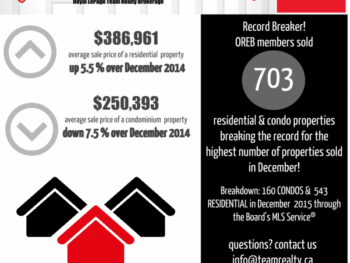
Record-breaking December, contributes to a strong 2015
Record-breaking December, contributes to a strong 2015 – Latest News from the Ottawa Real Estate Board Ottawa, January 6, 2016 – Members of the Ottawa Real Estate Board sold 703 residential properties in December through the Board’s Multiple Listing Service® System, compared with 638 in December 2014, an increase of 10.2 per cent. The five-year average for December sales is 653. The total number of residential and condo units sold through the Board’s MLS® System throughout all of 2015 was 14,658, compared with 13,919 in 2014, an increase of 5.3 per cent. Separately, residential and condounit sales each outperformed the 2014 numbers. “Looking back at the 2015 market, we started the year off with extreme cold temperatures in the first quarter of the year, but that didn’t stop homebuyers,” says new President of the Ottawa Real Estate Board, Shane Silva. “We saw the busy spring selling season pick up as early as March this year, and continue well throughout the summer, with a small dip in July, followed by record-breaking sale numbers in September. Three months later, December broke the record for the highest number of residential and condo properties sold at 703 units, only comparable to 2011, when 699 properties sold.” December’s sales included 160 in the condominium property class, and 543 in the residential property class. The condominium property class includes any property, regardless of style (i.e. detached, semi-detached, apartment, stacked etc.), which is registered as a condominium, as well as properties which are co-operatives, life leases and timeshares. The residential property class includes all other residential properties. “The listing inventory for both residential and condos trended higher all year, showing signs of tapering off in October,” says Silva. “Increased inventory levels contributed to the market favouring Buyers for much of the year; however as the inventory levelled out in the fall, we moved into more balanced conditions. Cumulative days on market increased to 109 days in December, while the average for the year comes in at 86 days. Average residential sale prices are up slightly over last year, which is great for the Ottawa market. All combined, these indicators point to a stable real estate market.” The average sale price of a residential-class property sold in December in the Ottawa area was $386,961, an increase of 5.5 per cent over December 2014. The average sale price for a condominium-class property was $250,393, a decrease of 7.5 per cent over December 2014. The year-to-date numbers for the average residential sale price in 2015 was $391,940, an increase of 1.9 per cent over 2014. While the average condominium sale price was $259,691, a decrease of 1.5 per cent over 2014. The Board cautions that average sale price information can be useful in establishing trends over time but should not be used as an indicator that specific properties have increased or decreased in value. The average sale price is calculated based on the total dollar volume of all properties sold. “A trend all year long, the hottest segments of our market are properties sold in the $300,000 to $400,000 price range, with 31.6 per cent of the year’s sales, followed by the $200,000 to $300,000 range, with 26.2 per cent of the year’s sales” says Silva. “In addition to residential and condominium sales, OREB Members assisted clients with renting 181 properties in December, and over 3,000 properties this year.” Source: Blog

Ottawa Real Estate Market Eases off with Cooler January Weather
Ottawa Real Estate “Market Snapshot” January 2016 Statistics are useful in establishing trends but should not be used as an indicator of an increase or decrease in value of specific properties. If you are curious about the value of your home and/or specific neighbourhood statistics we would be happy to provide you with information, no obligation, please contact us at info@teamrealty.ca if you have any questions. We look forward to hearing from you! _________________________________________________________________________________________________________ *provided by the Ottawa Real Estate Board Members of the Ottawa Real Estate Board sold 601 residential properties in January through the Board’s Multiple Listing Service® system, compared with 626 in January 2015, a decrease of four per cent. The five-year average for January sales is 618. “The market momentum gained from the warmer weather in the latter part of 2015 has eased off with the arrival of typical winter weather in January,” says President of the Ottawa Real Estate Board, Shane Silva. “We are seeing a drop in the number of residential and condo properties listed this January over the year before. However, the number of properties listed almost doubled the amount listed in December – a normal occurrence at the beginning of the year as people begin to plan for the year ahead.” January’s sales included 129 in the condominium property class, and 472 in the residential property class. The condominium property class includes any property, regardless of style (i.e. detached, semi-detached, apartment, townhouse, etc.), which is registered as a condominium, as well as properties which are co-operatives, life leases and timeshares. The residential property class includes all other residential properties. “Residential unit sales this month were down, while condominium unit sales were up, over last year,” says Silva. “Residential two-storey and bungalow homes continue to have the highest concentration of buyers, with three-storey homes increasing in sales by over 50 per cent since this time last year. Two-storey condominium properties had a similar increase, showing the same amount of unit sales as one-level properties.” The average sale price of a residential-class property sold in January in the Ottawa area was $386,839, an increase of 4.6 per cent over January 2015. The average sale price for a condominium-class property was $247,205, a decrease of 1.3 per cent over January 2015. The Board cautions that average sale price information can be useful in establishing trends over time but should not be used as an indicator that specific properties have increased or decreased in value. The average sale price is calculated based on the total dollar volume of all properties sold. “A possible explanation for the increase in residential average sale price this month over last year is that the amount of properties sold over $1 million doubled that of last year, with six properties sold this month,” notes Silva. “Nevertheless, the hottest segments of our market in January were sales in the $300,000 to $400,000 range, followed closely by the $200,000 to $300,000 range. In addition to residential and condominium sales, OREB members assisted clients with renting 200 properties in January.” Source: Blog
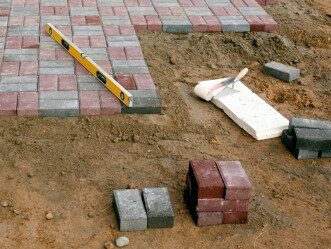
Your Guide to 10 Popular Landscape Paving Materials
If you are considering landscape paving, this excellent Houzz.com post by landscape architect Falon Mihalic includes guides to 10 of the most popular materials. Focused on cost, climate, maintenance and functional application, the guides explain the pros and cons of cast-in-place concrete, the cheapest option, pre-cast concrete, gravel, limestone, brick, slate, tile, bluestone, granite, and travertine. Mihalic also notes that many of the materials can be reused and suggests where the cost and/or environmentally conscious consumer can find them. To read more click here. Source: Blog

Your Complete Guide to Pest-Proofing This Fall
To prevent an onslaught of pests from occupying your house as the weather cools, simply follow the National Pest Management Association guidance presented in this post from Bob Villa. Seal cracks in the exterior envelope, especially where utility pipes enter, with silicone caulking. Fill larger gaps inside your home with steel wool. Pests avoid the roughness of the steel fibers and rodents cannot gnaw through it. Repair ripped window screens, door sweeps and loose mortar in the basement foundation, screen dryer vents and chimneys and replace weather stripping to seal these ideal entry points. If you suspect an infestation, hire a licensed pest control professional to assess the situation. To read more click here. Source: Blog

Ottawa Named 3rd Best City in the World for Quality of Life; Here’s Why
In this Point2Homes post, Nadia Balint attributes Ottawa’s stellar, but unsurprising (to locals), ranking in the recent Numbeo Quality of Life Index to three characteristics: Ottawa is young and fun with almost half the population under 35, it promotes and supports family life and the housing is relatively affordable. The Index rates factors like purchasing power, safety, property price to income ratio, and pollution. To read more click here. Source: Blog

9 Bad Habits That Are Killing Your Appliances
This slide show from Bob Villa is an excellent visual representation of how NOT to treat your appliances. For example, an overloaded washing machine stresses the bearings and misaligns the drum. Overfilling the freezer can block air vents, restrict the flow of cold air and overtax the condenser. Clean spills right after using the oven as they can damage the heating coils. To read more click here. Source: Blog

Higher electricity costs: how to circumvent them
Because the cost of electricity is expected to rise as a result of the federal Liberals’ green energy policies, prudent investors should pay attention to the energy consumption of their rental properties. This Canadian Real Estate Magazine post advises landlords to find ways to become more energy efficient such as installing programmable thermostats and motion sensor lights. More important is to pass the higher cost of hydro on to their tenants, whenever possible, and to implement an energy consumption ceiling for their all-inclusive leases. To read more click here. Source: Blog

Not Only Millennials Want Walkable Communities
A walkable community is well-planned, compact and designed for people to walk to work, school, parks restaurants and activities as a form of everyday transportation. According to a National Association of Realtors survey, more and more buyers want to live in walkable communities. The study found that fully 12% more Millennials, the generation born between the mid 1980′s and early 2000′s, would rather walk to their destination than drive. But, fitness enthusiasts and eco-friendly individuals also desire walkable neighbourhoods. Aging In Place Older Canadians want neighbourhoods that better fit their changing requirements. As baby boomers enter their retirement years, they will increase demand for senior housing and neighborhoods where they can more easily reach amenities, take care of daily needs, and access health care. The physical and/or financial requirements of maintaining their homes may be too much. Many cannot, or choose not to drive, so a development that is condensed, diverse, and walkable, with convenient public transport, gives them the ability to “age in place” (in the same home). Features of Walkable Communities a blend of shops, businesses and homes destinations (schools, stores, workplaces) within walking or biking distance sidewalks, pathways, green space, parks and infrastructure to support physical activities bike lanes and speed calming controls on roads trails and street crossings designed to make walking safe and accessible for everyone a variety of social, recreational, cultural, artistic and commercial activities public transport options to outlying destinations Benefits of Walkable Communities a more active, healthier population, no matter their age, income, gender or ability level safer neighbourhoods (i.e. fewer cars on the road, less accidents and injuries) improved air quality due to reduced greenhouse gas emissions a smaller environmental footprint reduces negative environmental impact positive social, recreational, cultural, artistic and commercial activities fosters a strong sense of place and give greater potential for social health lower combined housing and transportation costs , Real Estate Market Demand According to a U.S. Environmental Protection Agency report considering existing housing stock and consumer preferences, demand for new homes through 2025 might be almost exclusively for multi-family, attached and small-lot, single-family, detached homes. A 2010 analysis of real estate trends notes that “the two largest demographic groups in the country, the baby boomers and their children—together comprising half the population—want homes and commercial space in neighborhoods that do not exist in anywhere near sufficient quantity.” Another survey found that future demand for homes in compact neighborhoods could exceed 140 percent of the current supply. Conclusion With these demographic, lifestyle and development trends it is clear that diverse, attractive, healthy walkable communities will increase in popularity and not just for Millennials. Source: Blog
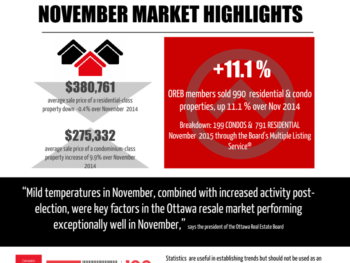
Ottawa Real Estate Update: November 2015
Mild weather and post-election enthusiasm spurs on home buyers! Statistics are useful in establishing trends but should not be used as an indicator of an increase or decrease in value of specific properties. If you are curious about the value of your home and/or specific neighbourhood statistics we would love to help. Contact us. Information below provided by the Ottawa Real Estate Board December 3rd, 2015 Members of the Ottawa Real Estate Board sold 990 residential properties in November through the Board’s Multiple Listing Service® System, compared with 891 in November 2014, an increase of 11.1 per cent. The five-year average for November sales is 944. “Mild temperatures in November, combined with increased activity post-election, were key factors in the Ottawa resale market performing exceptionally well in November,” says David Oikle, President of the Ottawa Real Estate Board. “The positive increase in condo sales may be explained by buyers moving to Ottawa to accept positions with the new government. There may have also been some pent up demand of people who chose to sit on the sidelines until after the election was over.” November’s sales included 199 in the condominium property class, and 791 in the residential property class. The condominium property class includes any property, regardless of style (i.e. detached, semi-detached, apartment, stacked etc.), which is registered as a condominium, as well as properties which are co-operatives, life leases and timeshares. The residential property class includes all other residential properties. “The condo market has picked back up over the past few months – a very positive change from the first half of the year, and now year-to-date condo sales have surpassed the numbers of units sold in 2014,” says Oikle. “Inventory levels are balancing out, cumulative days on market increased to 104 days, and average residential sale prices remain steady. This is very typical of a market that’s heading into the winter season.” The average sale price of a residential-class property sold in November in the Ottawa area was $380,761, a decrease of 0.4 per cent over November 2014. The average sale price for a condominium-class property was $275,332, an increase of 9.9 per cent over November 2014. The Board cautions that average sale price information can be useful in establishing trends over time but should not be used as an indicator that specific properties have increased or decreased in value. The average sale price is calculated based on the total dollar volume of all properties sold. “The highest concentration of properties sold remains in the $300,000 to $400,000 price range, followed very closely – behind by only 26 properties – the $200,000 to $300,000 range,” says Oikle. “In addition to residential and condominium sales, OREB members assisted clients with renting 247 properties in November, and over 2,800 since the beginning of the year.” Source: Blog

Why Cleaning Window Screens Should Be Part of Your Winter Strategy
Should removing and cleaning the window screens be part of your winter maintenance routine? According to this houzz.com post, there are several benefits to be gained. Simply put, dirty mesh blocks light, heat and the view. For example, you get 30 to 40 percent more light coming in without screens on the windows. More sunshine means you need less artificial light and can save on energy costs. In addition, removing the screens increases the solar energy getting through to the windows. Improved solar heat gain reduces the need for mechanical heating saving on heating bills. Also, during a storm, snow gets caught between the window and screen which can damage the frame. Wait until after the first freeze, to avoid bugs, and take the opportunity to inspect and repair the screens, where necessary. To avoid damage, vacuum the screens with a brush attachment. Then, use a soft brush or sponge to gently scrub them with a solution of dish soap and water. Don’t push too hard or the screen will be damaged. Rinse the windows with a hose, wipe them down on both sides and let them dry in the sun. Remember to mark each screen with its corresponding window to make spring installation easier. Finally, store them in a dry place where they won’t get damaged. To read more click here. Source: Blog

Create a beautiful bathroom for the ages
As people age, reduced mobility, impaired balance, failing vision and muscle weakness make them more susceptible to injuries in their home, and bathrooms are no exception. This Consumer Reports article tells how the latest design trends are helping owners upgrade their bathrooms with changes that enhance safety while retaining their beauty and avoiding an institutional look. In addition, subtle name changes have made useful improvements like shower rails (formerly called grab bars) and higher-seated toilets (“comfort height”) more acceptable. By widening the bathroom doorway, removing the raised sill and replacing knobs with easier-to-open handles you improve access. Installing slip-resistant tile or vinyl and/or shower bars will reduce the risk of falling. To reduce glare, mount lights on the side of your mirrors, not above, and bring in natural light with windows or skylights. Design the sink area to be suitable for all ages and abilities. Wall mount sinks provide room for someone who wants to sit, dual-level countertops help the youngsters and faucet levers are easier to turn than knobs. Open or glassed-in shelves make things easier to find. People with mobility issues can choose from curbless showers with seating and walk-in tubs with entry doors, sliding sides or wide edges to sit on while swinging their legs over the side. To read more click here. Source: Blog

Underwriting insights! What Every Homebuyer Should Know Before Applying for a Mortgage
This homeownership.ca post tells why an understanding of underwriting is a key advantage for home buyers seeking a mortgage. Work with a mortgage professional to get pre-approved for a mortgage so you know your price range and can make an offer instantly. The pre-approval process determines the size of mortgage and type of home you can afford. You will need to assemble your credit report and other documentation (financial and employment history, creditworthiness, income) the lender or mortgage insurer needs to process the application. The documentation required varies depending on individual circumstances. For example, self-employed applicants should be prepared to prove a consistent level of income over at least two years. To read more click here. Source: Blog
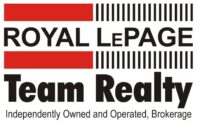
James Dean
Sales Representative
Royal LePage Team Realty
1335 Carling Avenue
Ottawa, Ontario
K1Z 8N8
Office: 613-725-1171
Direct: 613-293-2088
Fax: 613-725-3323
Toll Free: 1-800-307-1545
James@JamesDean.ca